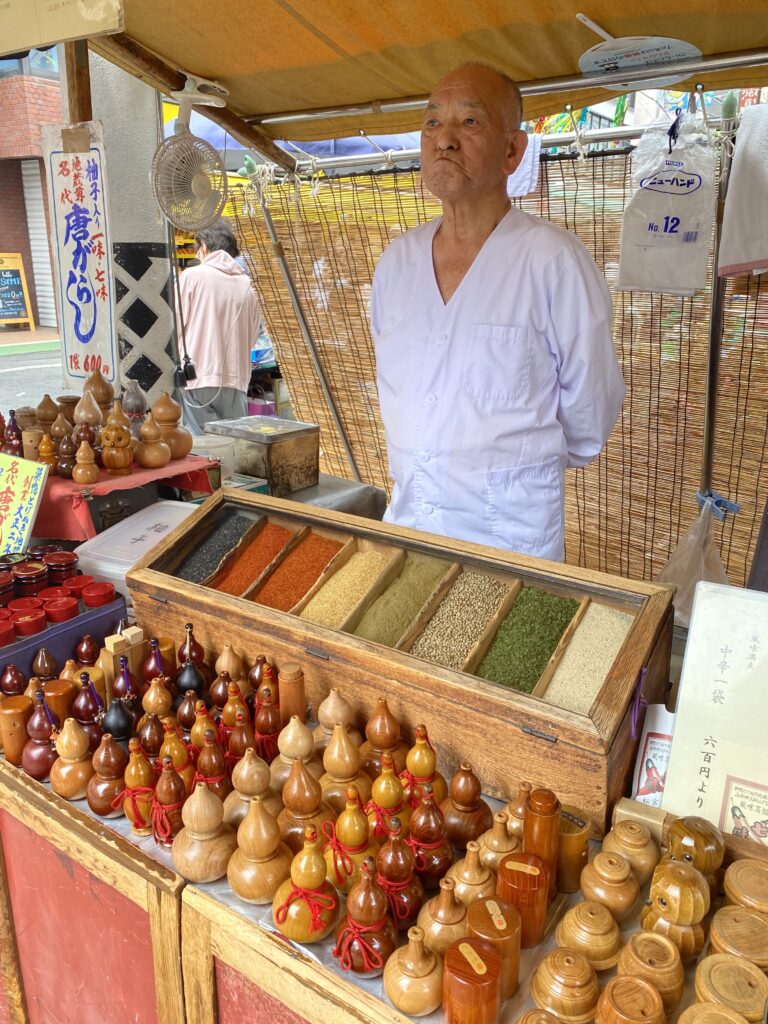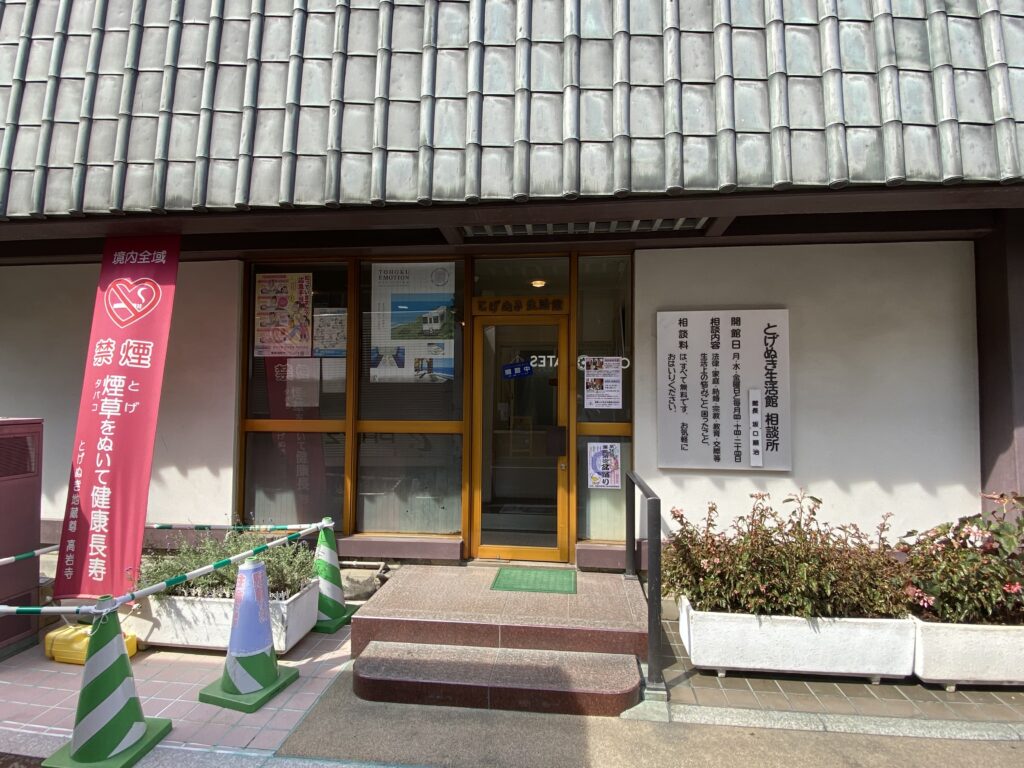By Sarah Pickard, Yihad Ali Safi, Yasmine Benaovadj
Togenuki Jizoson Koganji Temple (also known simply as Koganji) is located in Sugamo district in Tokyo, Japan, where it is only a short walk from the Jizo-Dori shopping street. Annually, Koganji sees over 8 million visitors and over 100,000 people come to the temple on Ennichi festival days which are held monthly on the 4th, 14th, and the 24th. The Ennichi festival aims to make people feel closer to Jizo and it came about from when the temple allowed souvenir stalls to set up along the path to the temple. This was because Koganji wanted to attract visitors to the temple in 1891. Those stalls then became the eateries and shops that are seen on the street today.
Koganji was founded in 1596. Originally, it was founded as a Soto Zen Buddhist temple but, when the temple was burnt down in the Great Meireki Fire of 1657, it was rebuilt at a new location and started to worship Jizo instead. In 1891, they were forced to move again due to urban redevelopment to its current location in Sugamo. The temple once again was destroyed during the war in 1945, and was rebuilt in 1958.
Koganji’s main object of worship is called Togenuki Jizo which translates to “thorn extraction Jizo.” The legend starts in the year 1713 in Koishikawa, Edo (Tokyo). It starts with the wife of a samurai who worshipped Jizo bodhisattva. She had just recently given birth to their son, but she had fallen ill and nothing was working to treat her. On her deathbed she confessed that a vengeful spirit had cursed her family where the women would not live past the age of twenty-five. Her husband Matashiro prayed every night and day for her to recover until one night a black robed monk appeared to him in his dreams. The monk then told Matashiro that he had to imprint a Jizo image on 10,000 pieces of paper and float them down the river. When Matashiro woke up from his dream, there was a small stamp next to his pillow with the Jizo image on it. He then used that stamp to stamp 10,000 pieces of paper with the Jizo image. The paper talisman was called an omikage. After he was done creating the 10,000 pieces of paper he floated them down the Sumida River while praying. The next day the wife told Matashiro that in her dream she saw the God of Death being repelled by a monk in a black robe and the wife started to get better and never got sick again.
One day, Matashiro was talking about his wife’s recovery with the Buddhist priest Saijun. Saijun asked for Jizo stamped paper talisman and was given two. Then one day in 1715, a housemaid at the Mori clan’s residence accidentally swallowed a broken needle. Luckily, Saijun was visiting the residence and had the talismans on him from Matashiro. He then told the maid to swallow the Jizo talisman with a cup of water. She did so and shortly afterwards she threw up and the talisman came out with the needle stuck inside of it. This story was written by Matashiro himself in 1728 and the temple has a written recording of it.
Soon after, the temple started to offer the paper talismans with the Jizo image imprinted on it. The miracle stories soon started to spread across Japan and stamps started to be made with the Jizo image. Because of this it started the ritual of people floating the 10,000 paper talismans on waterways.
Koganji Temple’s main worship is a tiny piece of paper that has the likeness of Togenuki Jizo imprinted on it. It is housed in a small chamber in the main altar and is considered a “hidden Buddha” which means that it is not shown to the public. But Koganji has a more visible object of worship too. Which is the Arai Kannon (washable Kannon), on the outside of the left side of the main worship hall. It is said that one can wash away their pain by washing the area of pain on the Kannon statue with water. The Arai Kannon statue was donated to the temple in 1657 by Yaneya Kiheiji in memory of his wife, who died in the Great Meireki fire that year. Over the years, the statue became worn due to the worshippers and weather conditions. In 1992, a new Kannon statue was donated by a late member of the temple Nakahori Yoshie and it was sculpted by Yatsuyanagi Naoki. To reduce wear and tear on the statue, worshippers now use a towel instead of a brush to wash the statue. The original statue is kept in a small chamber right behind the new statue.
Koganji’s 29th generation head and resident priest is Rev. Akinori Kuruma, who is a licensed medical doctor that specializes in cardiology. He studied at Nippon Medical School in Tokyo and at Emory University in Atlanta. After his father died, Rev. Kuruma found himself leaving the medical field and taking over the temple in 2005. Because he is a licensed medical professional he wanted to incorporate more modern medical practices alongside the temple’s healing traditions.
One initiative was to start a high-profile anti-smoking movement. While smoking was quickly banned at Koganji, it took a lot of convincing for the shops in the neighborhood to ban smoking too. Rev. Kuruma continues to be an anti-smoking activist and continues to give lectures about the dangers of smoking and secondhand smoke all over Japan.
In 2005, when AEDs were still a rarity, Rev. Kuruma was an early adopter. Soon they were installed at Koganji and around the neighborhood. Jizo-Dori soon became a model for other shopping districts to install AEDs. In 2007, Rev. Kuruma started to offer AED and CPR classes in Koganji’s social hall. Many merchants and residents took these classes, and Rev. Kuruma started to offer them for other organizations and temples. Since Rev. Kuruma had the AEDs installed, they have actually ended up saving a few lives over the years.
In addition, since 1959 Koganji has offered a free counseling center that has lawyers, social workers, priests, psychologists, and other professional counselors to help with problems that any person may face.
Rev. Kuruma believes that it is integral for Buddhist temples to be involved with their local community and help people while they are still alive even if Buddhist temples are primarily in Japan seen as a place for funerals. With Rev. Kuruma advocating these movements Koganji, has become a bastion for better health and a longer life.
Media










VR Tour
Click here to view the accessible version of this interactive content
External Links
- E.P. “Koganji Temple.” Koganji Temple | Japan Experience, 2 June 2016, www.japan-experience.com/all-about-japan/tokyo/temples-shrines/koganji-temple. Accessed 12 Dec. 2023.
- Koganji. “トップ.” 巣鴨とげぬき地蔵の由来, www.togenuki.jp/daihorin1992.html. Accessed 12 Dec. 2023.
- Ono, Philbert. “Koganji Temple (Togenuki Jizo) in Sugamo.” PHOTOGUIDEJP, 7 Jan. 2019, www.photoguide.jp/log/2019/01/koganji-temple-in-sugamo/. Accessed 12 Dec. 2023.
